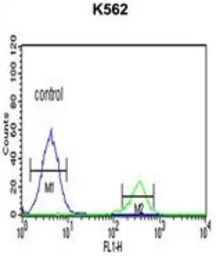APPLICATION
Application Note
*Optimal dilutions/concentrations should be determined by the researcher.
| Application |
Recommended Dilution |
| 1:1000 |
| 1:10-1:50 |
Not tested in other applications.
Calculated MW
PROPERTIES
Form
Liquid
Buffer
PBS
Preservative
0.09% Sodium azide
Storage
Store as concentrated solution. Centrifuge briefly prior to opening vial. For short-term storage (1-2 weeks), store at 4ºC. For long-term storage, aliquot and store at -20ºC or below. Avoid multiple freeze-thaw cycles.
Concentration
Batch dependent (Please refer to the vial label for the specific concentration.)
Antigen Species
Human
Immunogen
KLH conjugated synthetic peptide between 361-387 amino acids from the C-terminal region of human KIR3DS1.
Purification
Protein A purified, followed by peptide affinity purification.
Conjugation
Unconjugated
Note
For laboratory research use only. Not for any clinical, therapeutic, or diagnostic use in humans or animals. Not for animal or human consumption.
Purchasers shall not, and agree not to enable third parties to, analyze, copy, reverse engineer or otherwise attempt to determine the structure or sequence of the product.
TARGET
Synonyms
killer cell immunoglobulin like receptor, three Ig domains and short cytoplasmic tail 1 , CD158E2 , KIR-123FM , KIR-G1 , NKAT-10 , NKAT10
Cellular Localization
Cell membrane; Single-pass type I membrane protein
Background
Killer cell immunoglobulin-like receptors (KIRs) are transmembrane glycoproteins expressed by natural killer cells and subsets of T cells. The KIR genes are polymorphic and highly homologous and they are found in a cluster on chromosome 19q13.4 within the 1 Mb leukocyte receptor complex (LRC). The gene content of the KIR gene cluster varies among haplotypes, although several "framework" genes are found in all haplotypes (KIR3DL3, KIR3DP1, KIR3DL4, KIR3DL2). The KIR proteins are classified by the number of extracellular immunoglobulin domains (2D or 3D) and by whether they have a long (L) or short (S) cytoplasmic domain. KIR proteins with the long cytoplasmic domain transduce inhibitory signals upon ligand binding via an immune tyrosine-based inhibitory motif (ITIM), while KIR proteins with the short cytoplasmic domain lack the ITIM motif and instead associate with the TYRO protein tyrosine kinase binding protein to transduce activating signals. The ligands for several KIR proteins are subsets of HLA class I molecules; thus, KIR proteins are thought to play an important role in regulation of the immune response. Alternatively spliced transcript variants encoding different isoforms have been found for this gene. [provided by RefSeq, Aug 2013]
Database
Research Area
DATA IMAGES

|
GTX81103 FACS Image
FACS analysis of K562 cells using GTX81103 KIR3DS1 antibody, C-term.
Green : primary antibody
Blue : negative control
|

|
GTX81103 WB Image
WB analysis of K562 cell lysate (35ug/lane) using GTX81103 KIR3DS1 antibody, C-term.
|
REFERENCE
There are currently no references for KIR3DS1 antibody, C-term (GTX81103). Be the first to share your publications with this product.
REVIEW
There are currently no reviews for KIR3DS1 antibody, C-term (GTX81103). Be the first to share your experience with this product.



